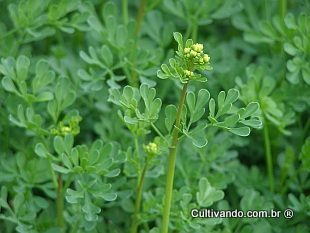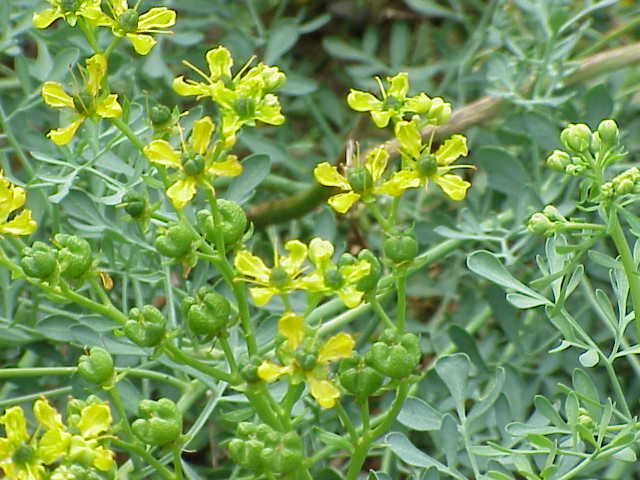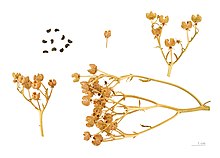 
Botanical: Ruta graveolens (LINN.)
Family: N.O. Rutaceae
---Synonyms---Herb-of-Grace. Herbygrass. Garden Rue.
---Part Used---Herb.
---Habitat---Southern Europe.
Rue, a hardy, evergreen, somewhat shrubby plant, is a native of Southern Europe. The stem is woody in the lower part, the leaves are alternate, bluish-green, bi- or tripinnate, emit a powerful, disagreeable odour and have an exceedingly bitter, acrid and nauseous taste. The greenish-yellow flowers are in terminal panicles, blossoming from June to September. In England Rue is one of our oldest garden plants, cultivated for its use medicinally, having, together with other herbs, been introduced by the Romans, but it is not found in a wild state except rarely on the hills of Lancashire and Yorkshire. This wild form is even more vehement in smell than the garden Rue. The whole plant has a disagreeable and powerful odour. The first flower that opens has usually ten stamens, the others eight only.[Top]
---Cultivation---The plant grows almost anywhere, but thrives best in a partially sheltered and dry situation. Propagation may be effected: (1) by seeds, sown outside, broadcast, in spring, raked in and the beds kept free from weeds, the seedlings, when about 2 inches high, being transplanted into fresh beds, allowing about 18 inches each way, as the plants become busy; (2) by cuttings, taken in spring and inserted for a time, until well rooted, in a shady border; (3) by rooted slips, also taken in spring. Every slip or cutting of the young wood will readily grow, and this is the most expeditious way of raising a stock.
Rue will live much longer and is less liable to be injured by frost in winter when grown in a poor, dry, rubbishy soil than in good ground.
Rue is first mentioned by Turner, 1562, in his Herbal, and has since become one of the best known and most widely grown simples for medicinal and homely uses.
The name Ruta is from the Greek reuo (to set free), because this herb is so efficacious in various diseases. It was much used by the Ancients; Hippocrates specially commended it, and it constituted a chief ingredient of the famous antidote to poison used by Mithridates. The Greeks regarded it as an antimagical herb, because it served to remedy the nervous indigestion they suffered when eating before strangers, which they attributed to witchcraft. In the Middle Ages and later, it was considered - in many parts of Europe - a powerful defence against witches, and was used in many spells. It was also thought to bestow second sight.
Piperno, a Neapolitan physician, in 1625, commended Rue as a specific against epilepsy and vertigo, and for the former malady, at one time, some of this herb used to be suspended round the neck of the sufferer.
Pliny, John Evelyn tells us, reported Rue to be of such effect for the preservation of sight that the painters of his time used to devour a great quantity of it, and the herb is still eaten by the Italians in their salads. It was supposed to make the sight both sharp and clear, especially when the vision had become dim through over-exertion of the eyes. It was with 'Euphrasy and Rue' that Adam's sight was purged by Milton's Angel.
At one time the holy water was sprinkled from brushes made of Rue at the ceremony usually preceding the Sunday celebration of High Mass, for which reason it is supposed it was named the Herb of Repentance and the Herb of Grace. 'There's rue for you and here's some for me; we may call it herb of grace o' Sundays.'
Gerard tells us: 'the garden Rue, which is better than the wild Rue for physic's use, grows most profitably, as Dioscorides said, under a fig tree.' But this is, probably, only a reference, originally, to the fact that it prefers a sheltered position.
Country-people boil its leaves with treacle, thus making a conserve of them. These leaves are curative of croup in poultry. It has also been employed in the diseases of cattle.
- Shakespeare refers again to Rue in Richard III:
- 'Here in this place
- I'll set a bank of rue, sour herb of grace;
- Rue, even for ruth, shall shortly here be seen,
- In the remembrance of a weeping queen.'
- The following is a quotation from Drayton:
- 'Then sprinkles she the juice of rue,
- With nine drops of the midnight dew
- From lunarie distilling.'
The latter was the Moonwort (Lunaria), often called 'honesty' - a common garden flower, with cross-shaped purple blossoms, and round, clear silvery-looking seed-vessels.Chaucer also calls it Lunarie.
- Gerard says:
- 'If a man be anointed with the juice of rue, the poison of wolf's bane, mushrooms, or todestooles, the biting of serpents, stinging of scorpions, spiders, bees, hornets and wasps will not hurt him.'
Rue-water sprinkled in the house 'kills all the fleas,' says an old bookThe juice was used against earache.
Rue has been regarded from the earliest times as successful in warding off contagion and preventing the attacks of fleas and other noxious insects. It was the custom for judges sitting at assizes to have sprigs of Rue placed on the bench of the dock against the pestilential infection brought into court from gaol by the prisoner, and the bouquet still presented in some districts to judges at the assizes was originally a bunch of aromatic herbs, given to him for the purpose of warding off gaol-fever.
It is one of the ingredients in the 'Vinegar of the Four Thieves.'
- Culpepper recommends it for sciatica and pains in the joints, if the latter be 'anointed' with it, as also for 'the shaking fits of agues, to take a draught before the fit comes.' He also tells us that:
- 'the juice thereof warmed in a pomegranate shell or rind, and dropped into the ears, helps the pains of them. The juice of it and fennel, with a little honey, and the gall of a cock put thereunto, helps the dimness of the eyesight.'
In Saxony Rue has given its name to an Order. A chaplet of Rue, borne bendwise on bars of the Coat Armour of the Dukedom of Saxony, was granted by Frederick Barbarossa to the first Duke of Saxony, in 1181. In 1902 the King of Saxony conferred the Order of the Rautenkrone (Crown of Rue) on our present King, then Prince of Wales. Since the latter half of the seventeenth century, sprigs of Rue have been interlaced in the Collar of our Order of the Thistle.[Top]
---Parts Used and Constituents---The whole herb is used, the drug consisting of both the fresh and the dried herb. The tops of the young shoots contain the greatest virtues of any part of the plant. The shoots are gathered before the plant flowers.
The volatile oil is contained in glands distributed over the whole plant and contains caprinic, plagonic, caprylic and oenanthylic acids - also a yellow crystalline body, called rutin. Oil of Rue is distilled from the fresh herb. Water serves to extract the virtues of the plant better than spirits of wine. Decoctions and infusions are usually made from the fresh plant, or the oil may be given in a dose of from 1 to 5 drops. The dried herb - which is a greyish green - has similar taste and odour, but is less powerful. It is used, powdered, for making tea.
[Top]
---Medicinal Action and Uses---Strongly stimulating and antispasmodic - often employed, in form of a warm infusion, as an emmenagogue. In excessive doses, it is an acro-narcotic poison, and on account of its emetic tendencies should not be administered immediately after eating.
It forms a useful medicine in hysterical affections, in coughs, croupy affections, colic and flatulence, being a mild stomachic. The oil may be given on sugar, or in hot water.
Externally, Rue is an active irritant, being employed as a rubefacient. If bruised and applied, the leaves will ease the severe pain of sciatica. The expressed juice, in small quantities, was a noted remedy for nervous nightmare, and the fresh leaves applied to the temples are said to relieve headache. Compresses saturated with a strong decoction of the plant, when applied to the chest, have been used beneficially for chronic bronchitis.
If a leaf or two be chewed, a refreshing aromatic flavour will pervade the mouth and any nervous headache, giddiness, hysterical spasm, or palpitation will be quickly relieved.
Uses
Traditional use
Common rue is said to promote the onset of menstruation and of uterine contractions; [citation needed] for this reason the refined oil of rue was cited by the Roman historian Pliny the Elder and the gynecologist Soranus as a potent abortifacient (inducing abortion). Rue contains pilocarpine which is used in horses to induce abortion.
It is also used in Brazil as the key ingredient in homemade herbal cough syrup, when mashed with caramelized sugar and honey.
Exposure to common rue, or herbal preparations derived from it, can cause severe phytophotodermatitis which results in burn-like blisters on the skin. [2][3][4][5]

Effect of the common rue on skin in hot weather
Culinary use
Rue does have a culinary use if used sparingly, but it is extremely bitter and severe gastric discomfort may be experienced by some individuals. Although used more extensively in former times, it is not a herb that typically suits modern tastes, and thus its use declined considerably over the course of the 20th century to the extent that it is today largely unknown to the general public and most chefs, and unavailable in grocery stores.
- It was used extensively in ancient Middle Eastern and Roman cuisine (according to Apicius).
- Rue leaves and berries are an important part of the cuisine ofEthiopia.
- Rue is used as a traditional flavouring in Greece and other Mediterranean countries.
- In Istria (a region in Croatia), and in Northern Italy, it is used to give a special flavour tograppa/raki and most of the time a little branch of the plant can be found in the bottle. This is called grappa alla ruta.
- Seeds can be used for porridge.
- The bitter leaf can be added to eggs, cheese, fish, or mixed with damson plums and wine to produce a meat sauce.
- In Italy in Friuli Venezia-Giulia, the young branches of the plant are dipped in a batter, deep-fried in oil, and consumed with salt or sugar. They are also used on their own to aromatise a specific type of omelette.
|









